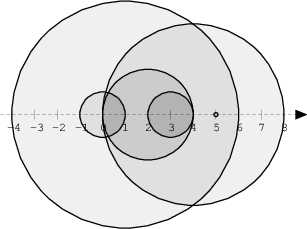We draw N discs on a plane. The discs are numbered from 0 to N − 1. An array A of N non-negative integers, specifying the radiuses of the discs, is given. The J-th disc is drawn with its center at (J, 0) and radius A[J].
We say that the J-th disc and K-th disc intersect if J ≠ K and the J-th and K-th discs have at least one common point (assuming that the discs contain their borders).
The figure below shows discs drawn for N = 6 and A as follows:
A[0] = 1 A[1] = 5 A[2] = 2 A[3] = 1 A[4] = 4 A[5] = 0
There are eleven (unordered) pairs of discs that intersect, namely:
- discs 1 and 4 intersect, and both intersect with all the other discs;
- disc 2 also intersects with discs 0 and 3.
Write a function:
int solution(vector<int> &A);
that, given an array A describing N discs as explained above, returns the number of (unordered) pairs of intersecting discs. The function should return −1 if the number of intersecting pairs exceeds 10,000,000.
Given array A shown above, the function should return 11, as explained above.
Write an efficient algorithm for the following assumptions:
- N is an integer within the range [0..100,000];
- each element of array A is an integer within the range [0..2,147,483,647].
// you can use includes, for example:
// #include <algorithm>
// you can write to stdout for debugging purposes, e.g.
// cout << "this is a debug message" << endl;
int solution(vector<int> &A) {
const int MAX_COUNT = 10000000;
size_t N = A.size();
// create arrays of frequency of left-hand edges, and rh edges
auto lhes = new vector<int>(N);
auto rhes = new vector<int>(N);
for (size_t i = 0; i < N; i++) {
// for all discs - count instances of edges at points
int lhs = max(0, static_cast<int>(i) - A[i]);
(*lhes)[lhs]++;
int rhs = min(N - 1, static_cast<int>(A[i]) + i);
(*rhes)[rhs]++;
}
int count = 0;
int overlapping = 0;
for (size_t i = 0; i < N; i++) {
// find number of new discs at this point
int newDiscs = (*lhes)[i];
count += newDiscs * overlapping;
count += newDiscs * (newDiscs - 1) / 2;
if (count > MAX_COUNT)
return -1;
// update with number of new discs, minus number now passed
overlapping += newDiscs - (*rhes)[i];
}
assert(count <= MAX_COUNT);
return count;
}func.cpp: In function 'int solution(std::vector<int>&)':
func.cpp:35:28: error: 'assert' was not declared in this scope
assert(count <= MAX_COUNT);
^
// you can use includes, for example:
// #include <algorithm>
// you can write to stdout for debugging purposes, e.g.
// cout << "this is a debug message" << endl;
#include <cassert>
int solution(vector<int> &A) {
const int MAX_COUNT = 10000000;
size_t N = A.size();
// create arrays of frequency of left-hand edges, and rh edges
auto lhes = new vector<int>(N);
auto rhes = new vector<int>(N);
for (size_t i = 0; i < N; i++) {
// for all discs - count instances of edges at points
int lhs = max(0, static_cast<int>(i) - A[i]);
(*lhes)[lhs]++;
int rhs = min(N - 1, static_cast<int>(A[i]) + i);
(*rhes)[rhs]++;
}
int count = 0;
int overlapping = 0;
for (size_t i = 0; i < N; i++) {
// find number of new discs at this point
int newDiscs = (*lhes)[i];
count += newDiscs * overlapping;
count += newDiscs * (newDiscs - 1) / 2;
if (count > MAX_COUNT)
return -1;
// update with number of new discs, minus number now passed
overlapping += newDiscs - (*rhes)[i];
}
assert(count <= MAX_COUNT);
return count;
}// you can use includes, for example:
// #include <algorithm>
// you can write to stdout for debugging purposes, e.g.
// cout << "this is a debug message" << endl;
#include <cassert>
int solution(vector<int> &A) {
const int MAX_COUNT = 10000000;
size_t N = A.size();
// create arrays of frequency of left-hand edges, and rh edges
auto lhes = new vector<int>(N);
auto rhes = new vector<int>(N);
for (size_t i = 0; i < N; i++) {
// for all discs - count instances of edges at points
int lhs = max(0, static_cast<int>(i) - A[i]);
(*lhes)[lhs]++;
int rhs = min(N - 1, static_cast<int>(A[i]) + i);
(*rhes)[rhs]++;
}
int count = 0;
int overlapping = 0;
for (size_t i = 0; i < N; i++) {
// find number of new discs at this point
int newDiscs = (*lhes)[i];
count += newDiscs * overlapping;
count += newDiscs * (newDiscs - 1) / 2;
if (count > MAX_COUNT)
return -1;
// update with number of new discs, minus number now passed
overlapping += newDiscs - (*rhes)[i];
}
assert(count <= MAX_COUNT);
return count;
}// you can use includes, for example:
// #include <algorithm>
// you can write to stdout for debugging purposes, e.g.
// cout << "this is a debug message" << endl;
#include <cassert>
int solution(vector<int> &A) {
const int MAX_COUNT = 10000000;
size_t N = A.size();
// create arrays of frequency of left-hand edges, and rh edges
auto lhes = new vector<int>(N);
auto rhes = new vector<int>(N);
for (size_t i = 0; i < N; i++) {
// for all discs - count instances of edges at points
int lhs = max(0, static_cast<int>(i) - A[i]);
(*lhes)[lhs]++;
int rhs = min(N - 1, static_cast<int>(A[i]) + i);
(*rhes)[rhs]++;
}
int count = 0;
int overlapping = 0;
for (size_t i = 0; i < N; i++) {
// find number of new discs at this point
int newDiscs = (*lhes)[i];
count += newDiscs * overlapping;
count += newDiscs * (newDiscs - 1) / 2;
if (count > MAX_COUNT)
return -1;
// update with number of new discs, minus number now passed
overlapping += newDiscs - (*rhes)[i];
}
assert(count <= MAX_COUNT);
return count;
}The solution obtained perfect score.